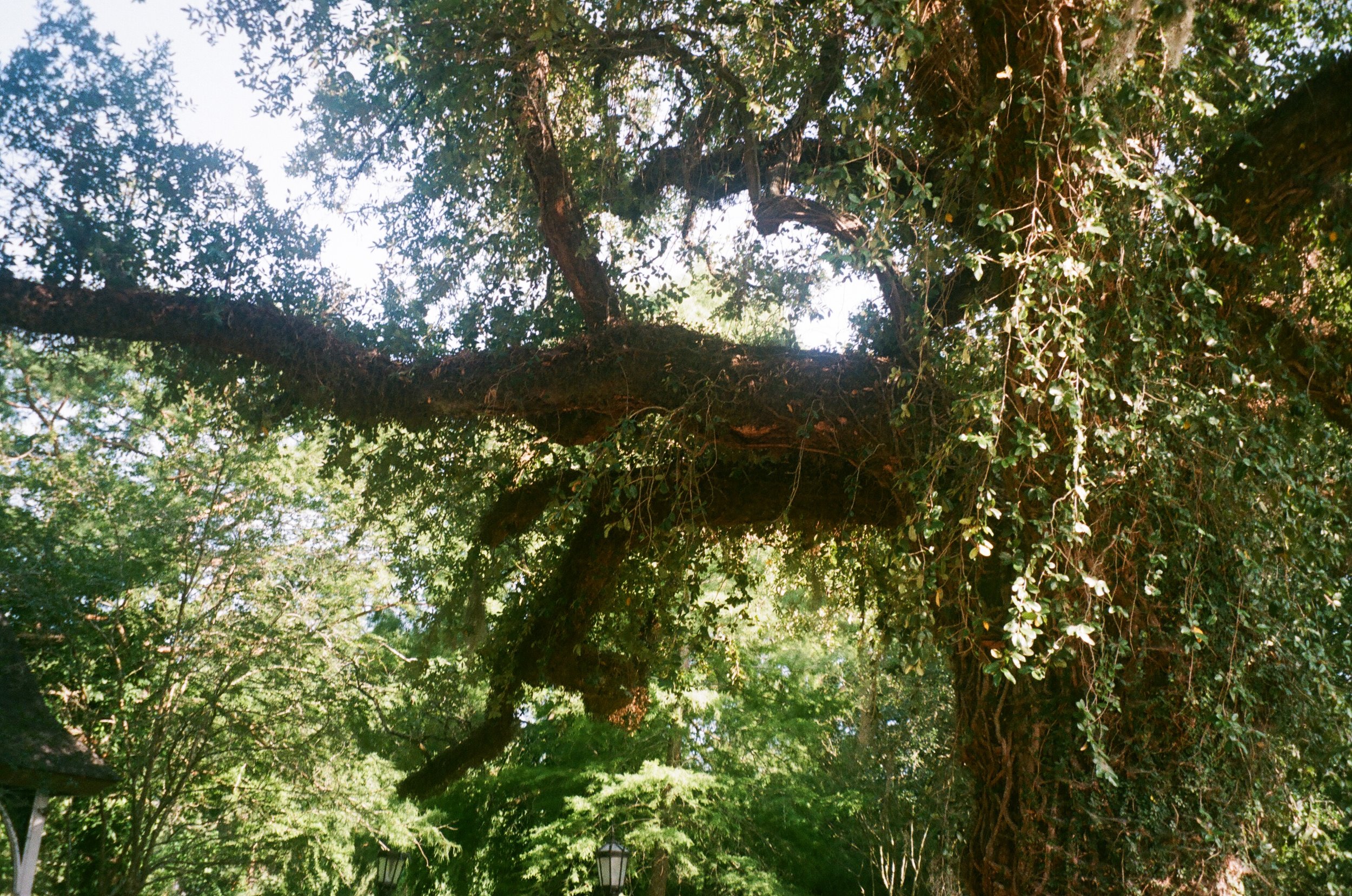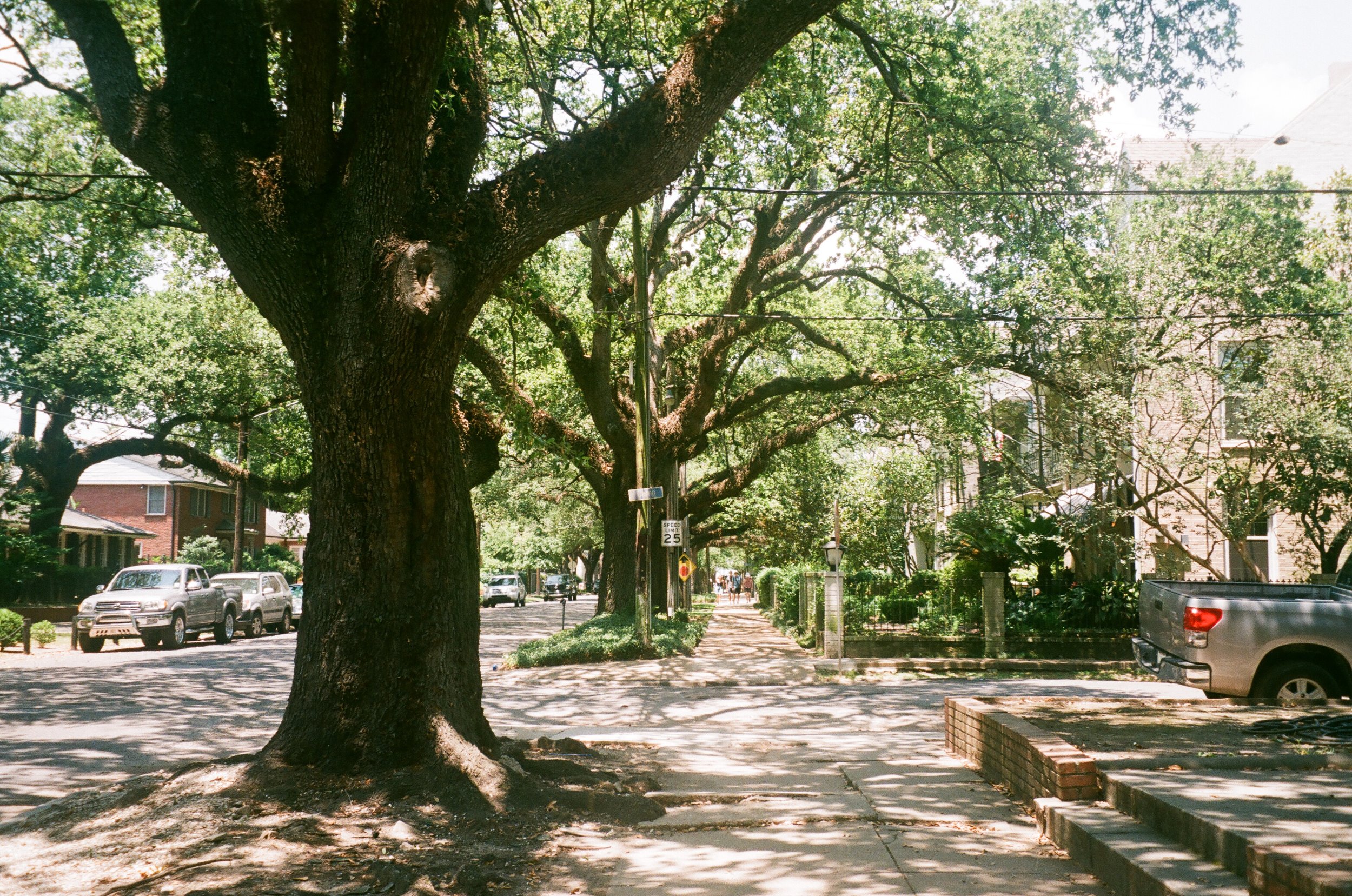I saw in Louisiana a live-oak growing,
All alone stood it and the moss hung down from the branches,
Without any companion it grew there uttering joyous leaves of dark green,
And its look, rude, unbending, lusty, made me think of myself,
But I wonder’d how it could utter joyous leaves standing alone there without its friend near, for I knew I could not,
And I broke off a twig with a certain number of leaves upon it, and twined around it a little moss,
And brought it away, and I have placed it in sight in my room,
It is not needed to remind me as of my own dear friends,
(For I believe lately I think of little else than of them,)
Yet it remains to me a curious token, it makes me think of manly love;
For all that, and though the live-oak glistens there in Louisiana solitary in a wide flat space,
Uttering joyous leaves all its life without a friend a lover near,
I know very well I could not.
- Walt Whitman" I Saw in Louisiana A Live-Oak Growing"
I was excited for the trees in Louisiana, the low-hung branches of mossy trees that stretch far over a shady ground that would otherwise feel the scorch of a heavy sun. In my head I've always pictured myself reading under a maternal tree like this, waving at the summer bugs and pulling at floral dress to cover my lightly dirt-marked knees. When I saw the trees, I was not disappointed. It was the trees that made me wonder if I had lived a past life in Louisiana. As we walked through the Garden District, I murmered that I was going to write about trees. Andrew smiled and stopped us, and read the poem by Walt Whitman. It is a romantic poem, with curves of curiosity and edges of lonliness - but it is beautiful. It was about a tree that probably stood in front of me - one of these trees held the memory of Mr. Whitman reaching up to pull a twig from its arms. I wanted this to be a romantic blog. But a few more beats of looking at the trees, remembering a tree I had seen in Grand Isle, and feeling stunned by images from museums and classrooms in my mind's eye, then I knew it could not only be that.
Trees are a symbol of nostalgia. They frame a memory in any person, whether it be your Christmas pine trees or tapping sap out of a maple tree or your backyard's eucalyptus scent. There may be the tree that was your favorite hiding spot, the one that held the tree house that always needed fixing, the fig tree that would drip fruit the neighbors dog would escape to eat, the tree whose branches held your after-school swing.
In the South, there is a nostalgia as fertile as the plush greenery and as thick as the roots and trunks of the oak trees that line the Garden District. The theme of Southern Gothic, a genre in which Interview With a Vampire falls with its aching decadence and death, romantically swings through ideas of a decaying beauty. We discussed in lecture how Southern Gothic represent a nostalgia for the "Old South" - a luxurious moment of medieval idealism. It is a nostalgia for that delicate beauty, for the time when these gorgeous homes were built. New Orleans homes were even built with nostalgia on the mind, as pillars echoed ancient Greek and Roman architecture that fill the myths and ornate fences whispered European descent.
Little girls dream of walking down the aisle in a garden next to a mesmerizing plantation home lined with mother-like trees laced in Spanish moss trees and humming to a chorus of crickets. There is a nostalgia for ladies in pretty dresses, chivalric men, the heartfelt warmth of Southern hospitality. If you type into Google "plantation home wedding venues," you'll find plenty of options.
On our trip, we visited the Whitney Plantation. Today's Whitney Plantation opened in 2015, a plantation-turned-musem focusing entirely upon the experience of slavery. It is the first, and only, of its kind in America - a public plantation that prioritizes the ugly truth over pretty nostalgia.
The romanticism of the old American South stretches turns a blind eye to the suffering, class lines, and inconsistencies of the past. The nostalgia is a thick cloud that blinds even the hindsight that is supposed to be 20/20. The sight that should see that the plantation the girl dreams of is stained with the sweat of thousands of black backs, and was watered by the tear ducts of enslaved ripped families and tortured individuals. The nostalgia thoughtlessly craves, in Langston Hughes's words, "The lazy, laughing South/with blood on its mouth"
View from the Big House on Whitney Plantation
Billie Holiday's song "Strange Fruit," in which she immortalizes the memory of bodies hanging from tree branches, has lyrics that express the bipolar nature of beauty/horror. This can be seen in much of the South's representation in honest art, like Langston Hughes' poem quoted above "The South." The lyrics display a split between the South's physical beauty and horror.
Pastoral scene of the gallant south/ The bulging eyes and the twisted mouth/ Scent of magnolias, sweet and fresh/ Then the sudden smell of burning flesh
Originating from a poem by New York writer Abel Meeropol, the song does not only dwell on the horror of dead bodies. The song gets its title from the "strange fruit" - human beings - hanging from the trees in the South.
Southern trees bear strange fruit/ Blood on the leaves and blood at the root/ Black bodies swinging in the southern breeze/ Strange fruit hanging from the poplar trees
To further my immersive learning, I have tried to be "moviepacking" alongside bookpacking. After visiting the Whitney Museum, I watched 12 Years a Slave. The film tells the story of Solomon, a free black men living in New York, who is tricked and captured to be sold into slavery. He, among, others, are shipped to New Orleans, the largest slave market in America. Solomon spends twelve years as a slave named "Platt."
The film, consciously or subconsciously, also displays the idea of beauty/horror by juxtaposing the physical "heavenliness" of Louisiana's natural beauty with hellish slavery and racist culture. The visual filmmaking choices are tied to reality - and do not diminish the natural beauty of the film locations in order to perpetuate a story of ugliness and terror. Shots would hold a lacy branch against a delicate sky, or show sensuous Southern grandeur before representations of enslavement crossed the screen. On a pretty summer Southern day, Solomon spends an entire day with a noose around his neck, tied to a grand oak tree with drooping Spanish moss that looks like it wants to caress him.
While Southern trees remember the georgeous gowns of Louisiana's elite and the small toes of a playful child, they are also remember the lives they took. Lynchings played an elemental part in torture and hate crimes. The third season of American Horror Story, "Coven," takes place in New Orleans so I added it to my "moviepacking" list. An episode begins with a young black boy dressed sharply in a white button down shirt riding his bicycle to his first day at a white school, only to be captured and hung by a group of white angry men. In 12 Years a Slave, an abusive plantation overseer attempts to hang Solomon for defending his hard work. He is stopped from going through with the hanging, but Solomon is left to tip toe in the mud for the whole day as punishment. The morning after I watched the film, Andrew discussed a famous photograph of a lynching. Here is a cropped version of the photograph. I have also included a photograph of a demonstration protesting lynching in Washington D.C., 1934.
Evangeline Tree in St. Martinville, Louisiana
I did not just see in Louisiana a live-oak growing, I saw in Louisiana live-oak remembering. It remembered beautiful times, laughter and carriages and bare feet and a first kiss - the tree above is the claimed meeting spot of the lovers that inspired Henry Wadsworth Longfellow's poem "Evangeline" - but it also remembered hearing hearts shattering, abuse, corrupt deals, and souls leaving a body. And the tree will continue to watch, as will all Southern trees and trees around the world. I embrace the Louisiana oak's beauty, and feel the power of its heartfelt memories and happiness, but I also let them honor the stories of those who faced injustice. They will sketch their memories with their roots in the ground, and they will whisper their secrets to their offspring carried by the wind. They will not act, but they will guide, teach, and watch, as we grow up and out and into ourselves - as humans, as animals, as a community, and a society.
To end, I am including an an old folk song that has always rung in my head, most famously performed by Eva Cassidy. It is called "Tall Trees in Georgia." The haunting melody leads lyrics of a woman reflecting on the Southern trees that watched her through her pink beloved youth and into her faded, lonely old age.
Tall trees in Georgia/they grow so high/they shade me so/And sadly walking through the thicket I go
The sweetest love/ I ever had/ I left aside/ Because I did not want to be any man's bride
But now I'm older/ and married I would be/ I found my sweetheart/ but he would not marry me
When I was younger/the boys all came around/ But now I'm older/ and they've all settled down
Control your mind my girl/ and give your heart to one/ For if you love all men/ you'll be surely left with none
Tall trees in Georgia/ they grow so high/ they shade me so/ And sadly walking/ through the thicket I go








